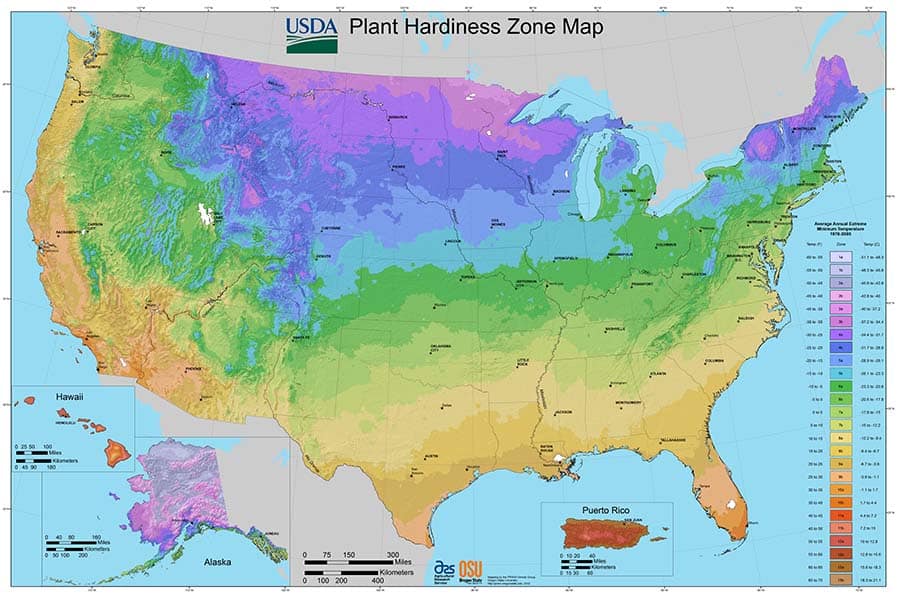If the old folktales are to be believed, the mischievous Jack Frost is far from innocent – he doesn’t simply paint the landscape white on cold mornings but poses a massive threat to your garden. If you’ve found that your plants have fallen victim to frost and become damaged, it’s good to know when it’s safe to trim them and how best to do it.
Frost damage is identifiable on plants by dry and brown foliage. This is caused by the plant’s cell walls rupturing due to water expansion as it freezes. You should wait until after the last average frost date for your area, at the very least, to begin pruning frost damage.
You may be tempted to bust out your trimming shears and lop off all that unsightly brown growth as soon as you notice it, but resist the urge – if you want to know why, as well as some tips on pruning your frost-damaged plants, read on.
When To Prune Frost-Damaged Plants
Frost, for the most part, is a seasonal occurrence. It arrives on clear mornings, giving the world a snowy white appearance as it settles on lawns and gardens. It might be pretty, but frost is bad news for your plants.
Wait until after the last average spring frost date for your area to prune your frost-damaged plants. If the damage has occurred mid-season, you can prune the plant, as long as the first average fall frost date has not passed.
The weather is usually impossible to predict, so you may find yourself in a cold snap with icy temperatures at unexpected times during the season. Pay attention to your local weather forecast to make sure you are not expecting any more frost in this case.
Why Not Prune Them Right Away?
You’ll be tempted to deal with frost as soon as possible, but stay away from your shears.
You shouldn’t prune them right away because the damaged parts of the plant can still protect healthy tissue from further damage by forming a layer of insulation against the frigid outside temperatures. The frost will settle on the dead tissue, rather than the healthy tissue underneath.
As you can see, trimming off the dead parts of your plant too early will do more harm than good. It’s best to stop yourself from soing so until you can be fairly certain that you aren’t expecting any more frost.
What Are Frost Dates?
What’s the best way to tell when the frost will stop? Nobody can predict the weather, but gardeners can refer to the average frost dates for their area to get an idea of when it’s safe to prune their frost-damaged plants.
Frost dates are average dates around which the seasonal frosts have either passed or are beginning again – the Last Spring Frost and First Fall Frost. Keep in mind that these are average dates, and you may still get frost before or after.
Generally speaking, frost dates are handy because they can help you avoid the icy blight. Depending on what you are growing and where you live, you might need to start a crop earlier in the season so their fruits can ripen properly before temperatures start falling again. If you have to plant during a frost period, you’ll have to take some precautions to keep it from killing your plants.
First and Last Frost Dates for Some Major US Cities
Here’s a handy table illustrating how frost dates can differ depending on your geographic location (you can refer to Old Farmers Almanac for frost dates of other US cities):
| City | First Fall Frost | Last Spring Frost |
| New York City, NY | 11/15 | 4/1 |
| Tampa, FL | 1/21 | 1/19 |
| Houston, TX | 12/20 | 2/8 |
| Atlanta, GA | 11/16 | 3/24 |
| Portland, OR | 11/15 | 3/23 |
Frost Dates Are Not a Hard and Fast Rule
As alluded to earlier while discussing when to prune frost-damaged plants, frost dates are not like Christmas even if they herald the coming or going of snow.
It is important to note that these are average dates calculated using data from the National Oceanic and Atmospheric Administration (NOAA).
Weather trends can be unpredictable, so it is important to be aware of your local weather forecast. You can also get a thermometer for your home use. The best time to check your thermometer is after sunrise.
The sun’s rays begin to excite the atmosphere, warming the air. As per science, hot air rises – this is why the temperature dips just after sunrise, in some cases creating the ideal conditions for frost to form.
You can put one of these Meggsi Indoor Digital Hygrometers Thermometers (available on Amazon.com) on your patio and check it in the mornings while you have your coffee, and keep personal notes on the temperature movements. If you begin to notice that your temperatures are at or near frost point consistently, it may be best to hold off on pruning your plants until next season.
How To Prune Frost-Damaged Plants
Now that we have established when you should or should not prune your frost-damaged plants, let’s explore the practice of actually pruning the poor things to give them the best shot at recovering:
- Assess the damage – You can check for living tissue by trying to snap a twig. If it bends, there might still be viable tissue.
- Prune from the tips downwards – Methodically trim off the damaged parts starting at the top. This helps avoid removing any undamaged parts hidden amongst the dead foliage.
- Add some fertilizer – The extra nutrients will encourage more growth
- Protect new growth from further damage – Even if the last average spring frost date has passed, a surprise frost could shatter any hopes of your plant surviving.
In some cases, you might have to prune significant amounts of the plant away that have been damaged by the frost. With a little faith, care, and patience, you might be surprised at how well your plants respond.
Familiarize Yourself With Cold Hardiness
All plants have each adapted in their own way to cope with the elements. Plants, much like people, are all different – they have preferences when it comes to climate, soil composition, and light cycles. You’ll have to look into this and determine how well your plant has adapted to the cold to determine its chances of survival.
Refer to the list maintained by the U.S. Department of Agriculture to find out how well a particular plant will handle the cold. Each plant is designated a minimum hardiness zone, helping gardeners to determine whether the plant is suitable for their environment.
You can sometimes find local hardiness maps, like these ones from the University of Wisconsin-Madison. They can give you an idea of what plants will grow best in your area – or at least give you an idea if you will need to take extra care against frost when growing a particular crop
Row Covers for Protecting Plants From Frost
Instead of risking losing your plants to the frost, you can install row covers to provide a layer of protection against the icy white death.
Row covers act as a form of insulation, preventing some of the warm air at ground level from escaping so that the frost forms on the outer surface of the row cover. They are usually made from a light, breathable material, and have wire hoops, so the cover does not rest on the plant.
In a pinch, you can use some old bedsheets to make some DIY row covers. You can also find many options on Amazon, like this FARAER Reusable Floating Row Cover. They are also nice to have if you need to protect your plants from insects and opportunistic birds.
Cold Frames
A cold frame is a bit like row covers in that it will protect your tender plants from early frosts but is a more permanent fixture, usually a wooden frame with a clear glass or plastic lid. Gardeners, in their creativity, often make them from salvaged and repurposed materials.
Follow this guide from Old Farmer’s Almanac to build your own cold frame. They are useful for starting seedlings early, or for crops you need to harvest later in the season after the first fall frost.
Watering Your Plants After a Frost
You might not be sure whether watering will aid or injure your plant further when frost damage occurs. The damage has been done, and the best thing for your plant is to keep watering it as normal.
Watering your plant after a frost helps thaw any frozen water in the ground. Plants cannot absorb water when it is frozen, and if there is any ice present in the soil, it will begin to die.
It seems counterintuitive to add more water when it is the very stuff that freezes to kill our plants, but you don’t want to overdo it. Just continue to water your frost-damaged plants as normal. Check out this article for more information about watering in the cold.
Conclusion
Frost is the enemy of every gardener, especially when it starts damaging our plants. Knowing when to prune them shouldn’t be a problem once you’ve established the average frost dates for your area and only pruning frost damage between the last spring frost and the first fall frost.
You can also adopt strategies to protect your plants from frost if it catches you unawares, but your mileage may vary depending on what you are growing and how resistant it is to cold weather.



